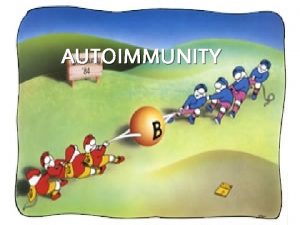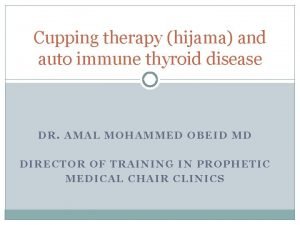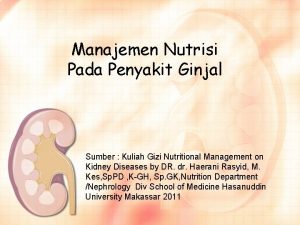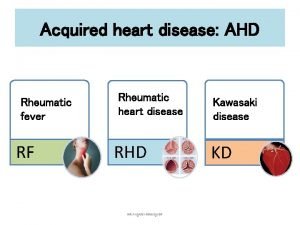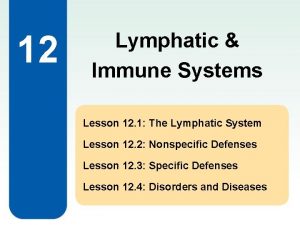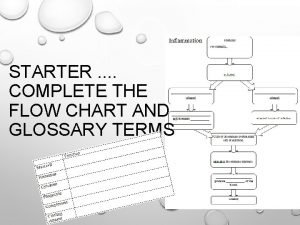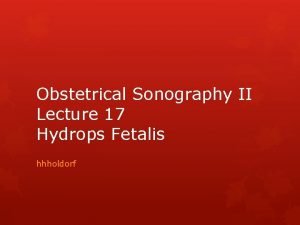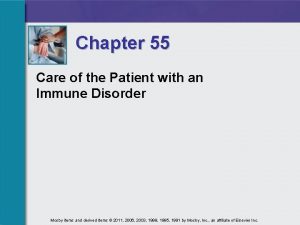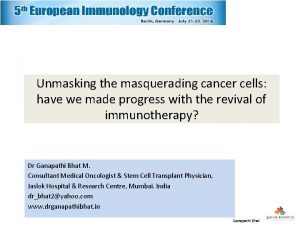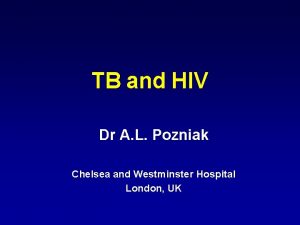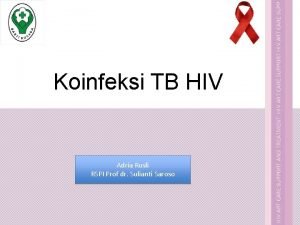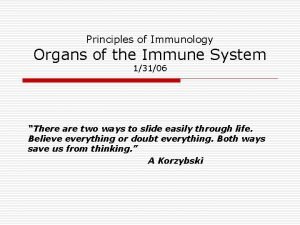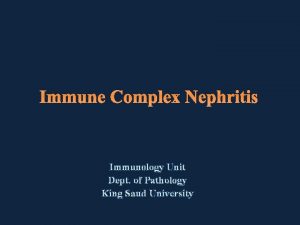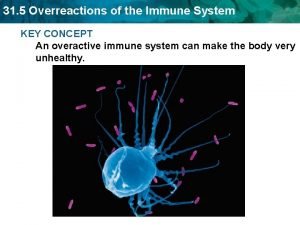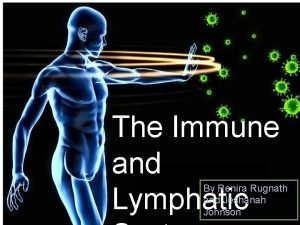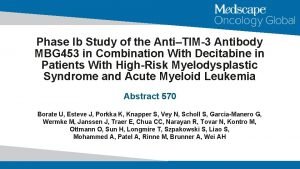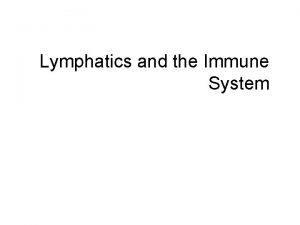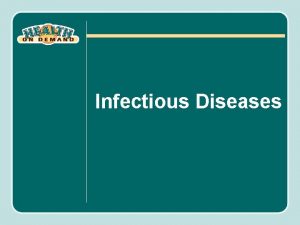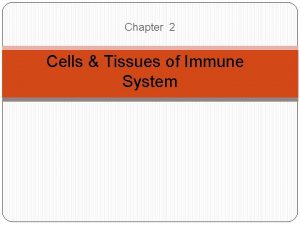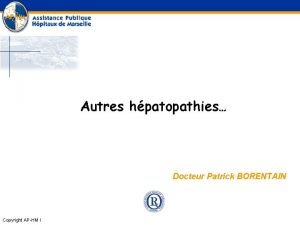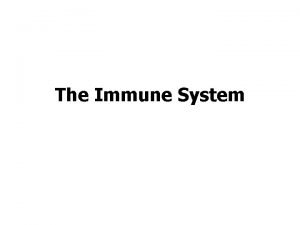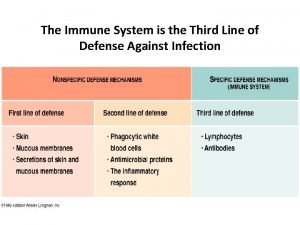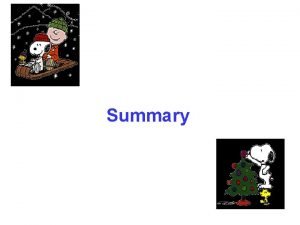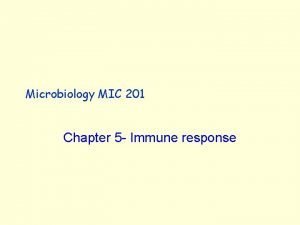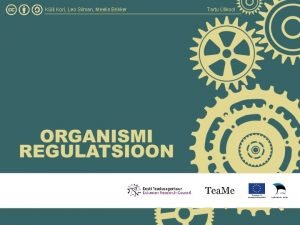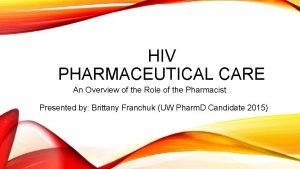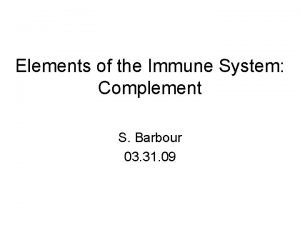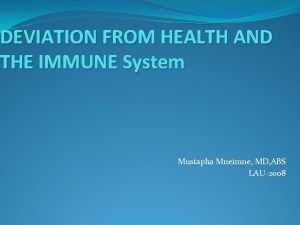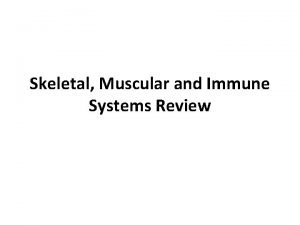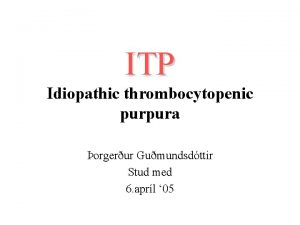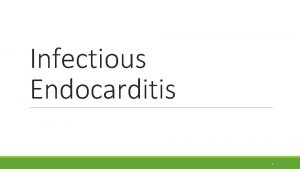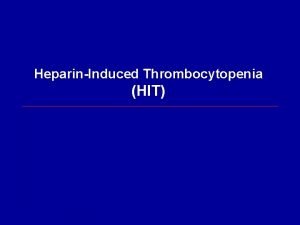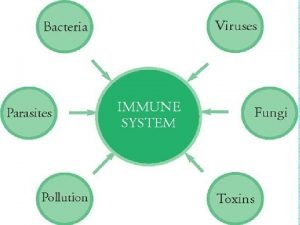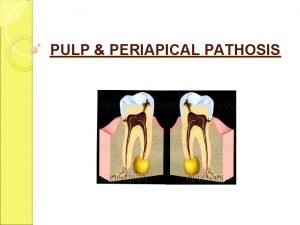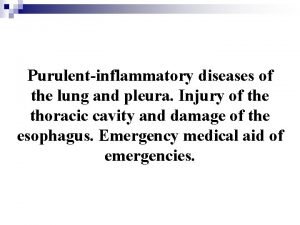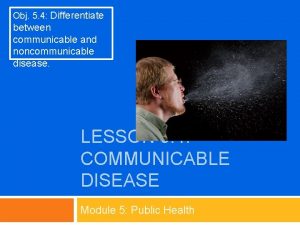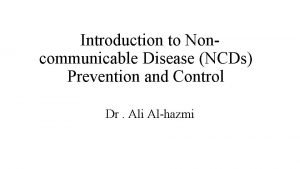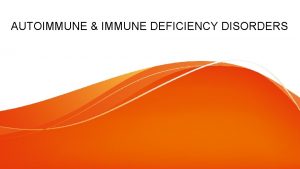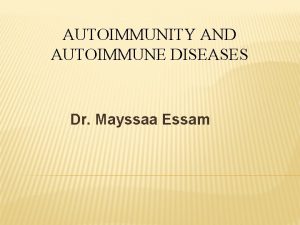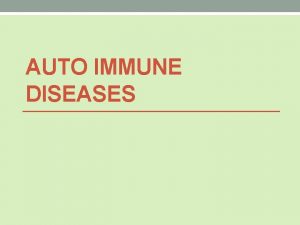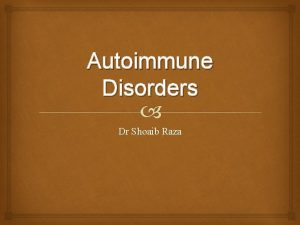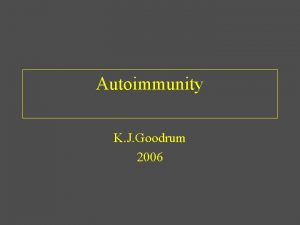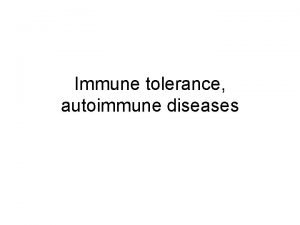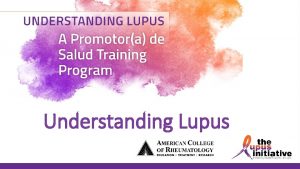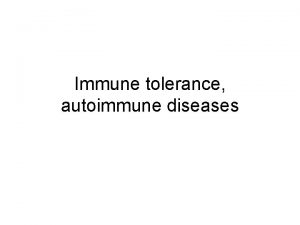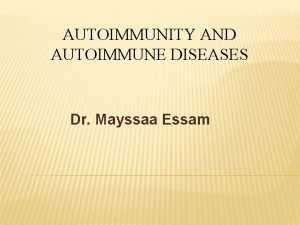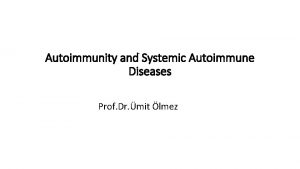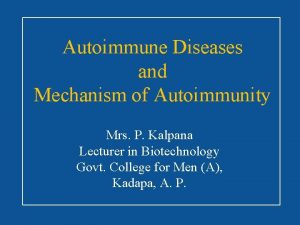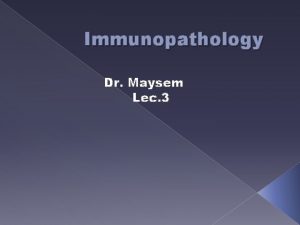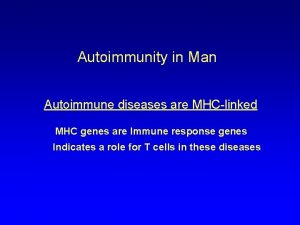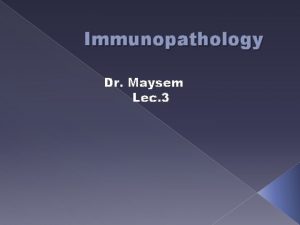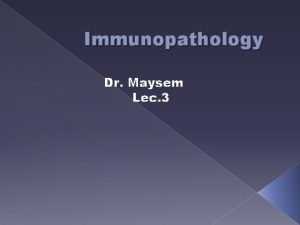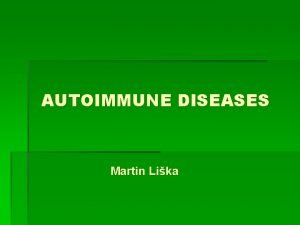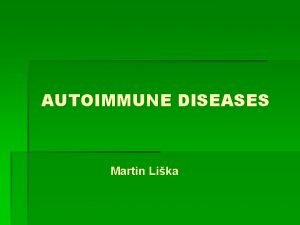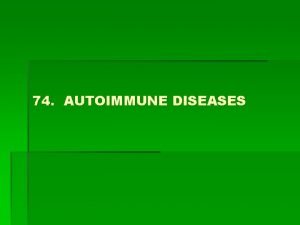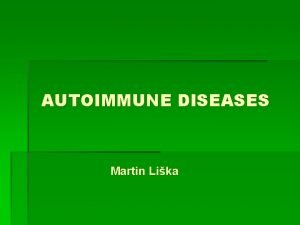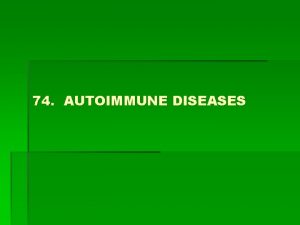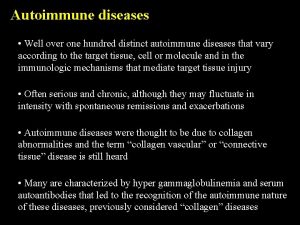AUTOIMMUNITY AND AUTOIMMUNE DISEASES DISORDERS OF THE IMMUNE


























































































- Slides: 90

AUTOIMMUNITY AND AUTOIMMUNE DISEASES

DISORDERS OF THE IMMUNE SYSTEM * Immunodeficiency • Too little * Hypersensitivity • Too much * Autoimmunity • Misdirected

AUTOIMMUNITY AND AUTOIMMUNE DISEASE * Autoimmunity • Adaptive immune response specific for self-antigens (autoantigens) • Exists due to random generation of TCR and BCR • Represents failures of mechanisms that maintain selftolerance in TCR and BCR * Autoimmune disease • Disease in which the pathology is caused by immune responses to self antigens of normal cells and organs


AUTOIMMUNITY * Paul Ehrlich (1854 – 1915) * In 1906 predicted existence and coined term * Referred to as * Horror autotoxicus * Medical community * Autoimmunity was not possible




AUTOIMMUNE DISEASES * A Group of 60 to 80 chronic inflammatory diseases with genetic predisposition and environmental modulation * Prevalence of 5% to 8% in US * Prevalence is greater for females than males • 75% of cases • 4 th largest disease class in women



RISK FACTORS FOR AUTOIMMUNE DISEASES * Genetic (HLA type) * HLADR 2 with SLE and MS * HLADR 3 with Sjogren’s syndrome, MG, SLE and DM-1 * HLADR 4 with RA and DM-1 * Female * X chromosome inactivation * Environmental * Smoking with RA * Drugs * Procainamide, minocycline, quinidine with DILE * Infections

HLA TYPE AS RISK FACTOR FOR AUTOIMMUNE DISEASES * Model 1 • Certain HLA alleles are better at presenting pathogen peptides which resemble self peptides to T cells * Model 2 • Certain HLA alleles are less efficient at presenting self peptides to developing T cells • Results in failure of negative selection

CLASSIFICATION OF AUTOIMMUNE DISEASES * Organ Specific • • • Insulin dependent diabetes mellitus (IDDM) - Type I Graves’ disease Goodpasture’s syndrome Myasthenia gravis Multiple sclerosis * Systemic • Systemic lupus erythematosus • Rheumatoid arthritis • Sjogren’s syndrome

CLASSIFICATION OF AUTOIMMUNE DISEASES BY EFFECTOR MECHANISMS * Type II • Antibody against cell-surface or extracellular matrix antigens (Type II hypersensitivity) * Type III • Formation and deposition of immune complexes (Type III hypersensitivity) * Type IV • T cell mediated (Type IV hypersensitivity)



TYPE II AUTOIMMUNE DISEASES * Ig. G antibody is primary effector mechanism * Attack more common • Cell surface antigens • Erythrocytes, neutrophils, platelets • Cell surface receptors • TSH, acetylcholine, insulin * Attack less common • Extracellular matrix autoantigens

EFFECTOR MECHANISM OUTCOMES IN TYPE II AUTOIMMUNE DISEASE * Cell surface antigen autoantibodies • Cell and tissue destruction * Cell surface receptor autoantibodies • Agonistic • Stimulate receptor • Antagonistic • Inhibit receptor


AUTOIMMUNE HEMOLYTIC ANEMIA * Destruction of erythrocytes by autoantibodies * Types • Warm (37 C) mediated by Ig. G • Cold (32 C) mediated by Ig. M * Causes of Warm • Idiopathic in 50% of cases • Diseases • Chronic lymphocytic leukemia • Systemic lupus erythematosus • Drugs • Penicillin, methyldopa, quinidine



AUTOIMMUNE HEMOLYTIC ANEMIA * Symptoms • Fatigue, pallor, SOB, tachycardia, jaundice, splenomegaly * Laboratory diagnosis • Coombs’ test • Direct (bound) and Indirect (free) • Elevated reticulocyte count * Treatment • Prednisone • Splenectomy • Immunosuppressive agents


WEGENER’S GRANULOMATOSIS * An uncommon pulmonary-renal disease * Characterized by granulomatous inflammation, necrosis and vasculitis primarily in URT, LRT and kidneys * Pathophysiology • Autoantibodies to proteinase-3 in neutrophil granules • Proteinase-3 translocates to surface following activation of neutrophils * Etiology is unknown and no genetic predispostion * Laboratory diagnosis • Antineutrophil cytoplasmic autoantibodies (ANCA) • Biopsy of lung and kidney




AUTOIMMUNE THROMBOCYTOPENIC PURPURA (ATP) * Synonym * Idiopathic thrombocytopenic purpura (ITP) * Pathophysiology • Ig. G autoantibodies against membrane glycoproteins on surface of thrombocytes (platelets) • Glycoprotein IIb/IIIa complex • Decrease in circulating thrombocytes (thrombocytopenia) • Reference range (150, 000 to 450, 000/u. L) • Clinical significance (< 50, 000/u. L) • Results in hemorrhage



AUTOIMMUNE THROMBOCYTOPENIC PURPURA (ATP) * Clinical forms • Acute in children (2 to 4 years) • Follows infection • Chronic in adults (20 to 50 years) • No specific cause * Risk factors • Diseases • SLE, HIV / AIDS • Drugs • Sulfonamides, ibuprofen, ranitidine, phenytoin, tamoxifen • Laboratory diagnosis • Complete blood count (CBC)

GOODPASTURE'S SYNDROME * An uncommon pulmonary-renal syndrome * Characterized by pulmonary hemorrhage and glomerulonephritis * Pathophysiology • Antibodies to type IV collagen in alveolar and glomerular basement membranes * Laboratory diagnosis • Anti-GBM (Ig. G to glomerular basement membrane) • Biopsy of lung and kidney


ACUTE RHEUMATIC FEVER (ARF) * Non-suppurative sequelae to pharyngitis by Streptococcus pyogenes (Group A Streptococcus / GAS) * 2 to 3 weeks following pharyngitis * Characterized by • Painful polymigratory arthritis • Carditis * Female to male ratio of 1: 1 * Incidence of 0. 5% to 3%

ACUTE RHEUMATIC FEVER (ARF) * Highest incidence/prevalence between 6 and 20 years • Rare >30 years * Effector mechanism • Antibodies to GAS “M” proteins cross reacting to antigens of heart and joints (molecular mimicry) * Associated with rheumatogenic strains • M 1, M 3, M 5, M 6, M 18

ACUTE RHEUMATIC FEVER (ARF) * Radiographic diagnosis • CXR for cardiomegaly * Laboratory diagnosis • Anti-streptolysin-O (ASO) • Reference ranges • 0 to 3 years • 4 to 17 years • Anti-DNase. B • CRP < 250 IL/m. L <400 IL/m. L



GRAVES' DISEASE * Most common cause of hyperthyroidism (thyrotoxicosis) • Incidence of 50 -80 cases / 100, 000 population / year • Female to male ratio of 8: 1 * Effector mechanisms involve auto-reactive antibodies • Thyroid stimulating hormone (TSH) receptor (Thyrotropin receptor) • Thyroid peroxidase / Thyroperoxidase (TPO) • Thyroglobulin • T 3 and T 4


GRAVES' DISEASE * Symptoms • Fatigue, heat intolerance, weight loss, anxiety, restlessness, insomnia, ophthalmopathy * Laboratory diagnosis • Increase in free T 3 (triiodothyronine) and T 4 (thyroxine) serum levels • Decrease in thyroid stimulating hormone (TSH) serum level • Detection of thyroid stimulating hormone (TSH / Thyrotropin) receptor antibody in serum


GRAVES' DISEASE * Risk factors * HLADR 3 * Smoking for ophthalmopathy (5 x) * Treatment • Anti-thyroid drugs • Methimazole (Tapazole) • Radioactive iodine • I-131 • Surgery • Thyroidectomy




HASHIMOTO'S DISEASE (THYROIDITIS) * Alternative names • Chronic lymphocytic thyroiditis • Autoimmune thyroiditis * Female to male ratio of 12: 1 * Effector mechanisms • Autoantibodies specific for • Thyroglobulin • Thyroid peroxidase • CD 8 T cells

HASHIMOTO'S DISEASE (THYROIDITIS) * Most common cause of hypothyroidism in US * Symptoms • Fatigue, cold intolerance, weight gain, depression, enlarged gland * Laboratory diagnosis • T 3, T 4 (decrease) and TSH (increase) serum levels • Autoantibodies to • Thyroid peroxidase (TPO) • Thyroglobulin * Treatment • Replacement therapy (Levothyroxine)


INSULIN RESISTANCE (SYNDROME / DIABETES) * Cells of body display impaired response to effects of insulin * Obesity is most common cause * Precedes Type 2 diabetes * Etiology • Genetic • Mutational events • Acquired • Physical inactivity, medications, diet, aging process

ETIOLOGICAL CATEGORIES OF INSULIN RESISTANCE * Pre-receptor • Abnormal insulin • Antibody to insulin * Receptor • Decreased number of receptors • Mutated receptors • Autoantibody against receptors • Antagonistic • Agonistic * Post-receptor • Defective signal transduction

AUTOIMMUNE INSULIN RECEPTOR DISEASE * Results in either elevated or decreased levels of glucose in blood * Mechanisms • Autoantibodies against insulin receptors on cells * Autoantibodies • Antagonistic • Result in hyperglycemia • Insulin resistant diabetes • Agonistic • Results in hypoglycemia

TYPE III AUTOIMMUNE DISEASES * Directed against autoantigens of many cells of body • Cell surfaces, cytoplasm and nucleus (nucleic acids and nucleoproteins) • Antibody binding initiates inflammatory reactions and soluble immune complexes * Directed against one or two different tissue • Clinical manifestations are systemic

POST-STREPTOCOCCAL ACUTE GLOMERULONEPHRITIS (PSAGN) * Non-suppurative sequelae following pharyngitis and skin infections by Group A Streptococcus (GAS) * 1 to 3 weeks following pharyngitis and skin infections * Characterized by • Edema (peri-orbital) • Hematuria • Hypertension * Male to female ratio of 2: 1

POST-STREPTOCOCCAL ACUTE GLOMERULONEPHRITIS (PSAGN) * Highest incidence/prevalence between 4 to 12 years * Antigens from "Nephritogenic strains“ * M 2, M 12, M 49, M 57, M 59, M 60 * Effector mechanism • Deposition of soluble immune complexes in glomeruli * Laboratory diagnosis • Anti-streptolysin O (ASO) [skin infections show poor response] • Anti-DNase. B • C 3




SYSTEMIC LUPUS ERYTHEMATOSUS (SLE) * Chronic, multi-system inflammatory disease with protean manifestations and remitting course * Clinical manifestations * Musculoskeletal (joint and muscle pain) * Dermatological (malar rash) * Renal (glomerulonephritis) * Female to male ratio of 9: 1 * Etiology is unknown • Genetics, race, hormones, environment



SYSTEMIC LUPUS ERYTHEMATOSUS (SLE) * Effector mechanisms • Autoantibodies to many autoantigens • Most common autoantibody is to ds-DNA • Immune complex deposition on basement membranes with complement activation and inflammation * Laboratory diagnosis • Anti-nuclear antibody (ANA) • IFA (indirect fluorescent antibody) assay using HEp-2 cells • Homogeneous pattern and titer > 1: 160 • Anti ds-DNA • IFA assay using Crithidia lucilliae • C 3 level



TYPE IV AUTOIMMUNE DISEASES * Mediated by T cells • CD 4 TH 1 • CD 8 * Organ specific and systemic AD * It is difficult to identify autoimmune T cells and the autoantigen

INSULIN-DEPENDENT DIABETES MELLITUS (IDDM) * Synonym • Type I diabetes, DM-type I * Accounts for 5% to 10% of diabetes in US * Female to male ratio of 1: 1 * Effector mechanisms • CD 8 T cells and autoantibodies against beta cells • Glutamic acid decarboxylase (GAD) • Insulin


PATHOPHYSIOLOGY OF IDDM * Pancreatic beta cells are damaged by • Infectious agents • Mumps virus, rubella virus, coxsackie B virus • Toxic chemicals * Damaged beta cells present antigens which trigger immune attack in genetically susceptible * Genetic susceptibility • HLA-DQ • HLA-DR 3 • HLA-DR 4




INSULIN-DEPENDENT DIABETES MELLITUS (IDDM) * Symptoms • • • Increased thirst Frequent urination Increased hunger Weight loss Fatigue * Laboratory diagnosis • Random blood glucose (>200 mg/d. L) • Fasting blood glucose (>126 mg/d. L)

RHEUMATOID ARTHRITIS (RA) * Characterized by inflammation of synovial membrane of joints and articular surfaces of cartilage and bone * Vasculitis is a systemic complication * Affects 3% to 5% of U. S. population * Female to male ratio of 3: 1 * HLA DR 4 is genetic risk factor



RHEUMATOID ARTHRITIS (RA) * Effector mechanism • CD 4 T cells, activated B cells, macrophages and plasma cells • 85% of patients have rheumatoid factor * Rheumatoid factor • Ig. M, Ig. G and Ig. A specific for Ig. G • Immune complex formation exacerbates inflammation * Laboratory diagnosis • Rheumatoid factor (RF) • Anti-cyclic citrullinated peptide (Anti-CCP) • C-reactive protein (CRP)

TREATMENT OF RHEUMATOID ARTHRITIS * Fast-acting, first line drugs * Non-steroidal anti-inflammatory drugs (NSAIDs) * Corticosteroids * Analgesic drugs * Slow-acting, second line drugs (Disease-Modifying Antirheumatic Drugs / DMARDs) * * Hydroxychloroquine (Plaquenil) Methotrexate (Rheumatrex) Azathioprine (Imuran) Human monoclonal antibody to TNF-alpha * Infliximab (Remicade) * Adalimumab (Humira) * Etanercept (Enbrel)


MULTIPLE SCLEROSIS (MS) * Chronic unpredictable disease of CNS with four possible clinical courses * Characterized by patches of demyelination and inflammation of myelin sheath * Prevalence higher in Northern Hemisphere • North of 37 th parallel (125 cases /100, 000) • South of 37 th parallel (70 cases /100, 000) * Female to male ratio of 2: 1



MULTIPLE SCLEROSIS (MS) * Effector mechanisms • Myelin basic protein is primary autoantigen for CD 4 TH 1 cells * Radiology diagnosis • MRI for detecting demyelinating lesions (plaques) • Laboratory diagnosis • High resolution protein electrophoresis for • Oligoclonal bands in CSF






 Primary immune response and secondary immune response
Primary immune response and secondary immune response Autoimmunity literally means
Autoimmunity literally means Define a primary skin lesion and list three types
Define a primary skin lesion and list three types Chapter 6 musculoskeletal system
Chapter 6 musculoskeletal system Chapter 21 mental health diseases and disorders
Chapter 21 mental health diseases and disorders Chapter 17 reproductive system diseases and disorders
Chapter 17 reproductive system diseases and disorders Chapter 15 nervous system diseases and disorders
Chapter 15 nervous system diseases and disorders Milady chapter 10 nail disorders and diseases
Milady chapter 10 nail disorders and diseases Chapter 8 skin disorders and diseases
Chapter 8 skin disorders and diseases What conditions do fungal organisms favor for growth?
What conditions do fungal organisms favor for growth? Chapter 8 cardiovascular system
Chapter 8 cardiovascular system Milady chapter 8 skin disorders and diseases
Milady chapter 8 skin disorders and diseases Chapter 10 lymphatic system diseases and disorders
Chapter 10 lymphatic system diseases and disorders Cupping and autoimmune disease
Cupping and autoimmune disease Penyebab pew pada ckd
Penyebab pew pada ckd Crohn's disease
Crohn's disease Preload and afterload
Preload and afterload Chapter 24 the immune and lymphatic systems and cancer
Chapter 24 the immune and lymphatic systems and cancer Lymph diagram
Lymph diagram Chapter 35 immune system and disease
Chapter 35 immune system and disease Body third line of defense
Body third line of defense Lesson 12 blood and immune system
Lesson 12 blood and immune system Lesson 12 blood and immune system
Lesson 12 blood and immune system Primary and secondary immune response
Primary and secondary immune response Lingual tonsil
Lingual tonsil What is the third line of defense in the immune system
What is the third line of defense in the immune system Flow chart
Flow chart Any substance capable of provoking an immune response
Any substance capable of provoking an immune response Non immune hydrops fetalis
Non immune hydrops fetalis Active artificial immunity
Active artificial immunity Second line of defense immune system
Second line of defense immune system Chapter 55 care of the patient with an immune disorder
Chapter 55 care of the patient with an immune disorder Ap bio immune system
Ap bio immune system Cancer vaccines
Cancer vaccines Immune reconstitution inflammatory syndrome
Immune reconstitution inflammatory syndrome Dr adria rusli
Dr adria rusli Immune system lymph nodes
Immune system lymph nodes Immune system def
Immune system def Immune complex glomerulonephritis
Immune complex glomerulonephritis Overreactions of the immune system
Overreactions of the immune system Lymphatic vs immune system
Lymphatic vs immune system Nct03946670
Nct03946670 Lymphatic vs immune system
Lymphatic vs immune system Defination of infection
Defination of infection Primary immune response
Primary immune response Immune effector cells
Immune effector cells Immune response controller crossword
Immune response controller crossword Dr patrick kormann
Dr patrick kormann Immune defintion
Immune defintion Immune system lines of defense
Immune system lines of defense Lupus
Lupus What is the main function of the immune system
What is the main function of the immune system Cellular immune response
Cellular immune response Ctl
Ctl Cellular immune response
Cellular immune response Thymus
Thymus Immunity definition
Immunity definition Immune reconstitution therapy
Immune reconstitution therapy Mac immune system
Mac immune system Thalassemia facies
Thalassemia facies Vaccinations help prepare the body to fight invasions of
Vaccinations help prepare the body to fight invasions of Maladie auto immune connectivite
Maladie auto immune connectivite Immune thrombocytopenic purpura
Immune thrombocytopenic purpura Immune complex
Immune complex Immune thrombocytopenia
Immune thrombocytopenia Virosome
Virosome 1what's the purpose of the body's immune system?
1what's the purpose of the body's immune system? Modern lifestyle and hypokinetic diseases
Modern lifestyle and hypokinetic diseases Is athlete's foot communicable or noncommunicable
Is athlete's foot communicable or noncommunicable Section 19-3 diseases caused by bacteria and viruses
Section 19-3 diseases caused by bacteria and viruses Chapter 24 sexually transmitted diseases and hiv/aids
Chapter 24 sexually transmitted diseases and hiv/aids Chapter 22 genetics and genetically linked diseases
Chapter 22 genetics and genetically linked diseases Icd 10 morbus hansen
Icd 10 morbus hansen Chronic pulpitis
Chronic pulpitis Venn diagram of communicable and non-communicable diseases
Venn diagram of communicable and non-communicable diseases Purulent diseases of lungs and pleura
Purulent diseases of lungs and pleura Tronsmo plant pathology and plant diseases download
Tronsmo plant pathology and plant diseases download Tronsmo plant pathology and plant diseases download
Tronsmo plant pathology and plant diseases download Tronsmo plant pathology and plant diseases download
Tronsmo plant pathology and plant diseases download Venn diagram of communicable and non-communicable diseases
Venn diagram of communicable and non-communicable diseases Examples of macronutrients elements
Examples of macronutrients elements Myths and fallacies about non communicable diseases
Myths and fallacies about non communicable diseases Hát kết hợp bộ gõ cơ thể
Hát kết hợp bộ gõ cơ thể Frameset trong html5
Frameset trong html5 Bổ thể
Bổ thể Tỉ lệ cơ thể trẻ em
Tỉ lệ cơ thể trẻ em Gấu đi như thế nào
Gấu đi như thế nào Tư thế worm breton là gì
Tư thế worm breton là gì Alleluia hat len nguoi oi
Alleluia hat len nguoi oi Môn thể thao bắt đầu bằng chữ đua
Môn thể thao bắt đầu bằng chữ đua Thế nào là hệ số cao nhất
Thế nào là hệ số cao nhất

